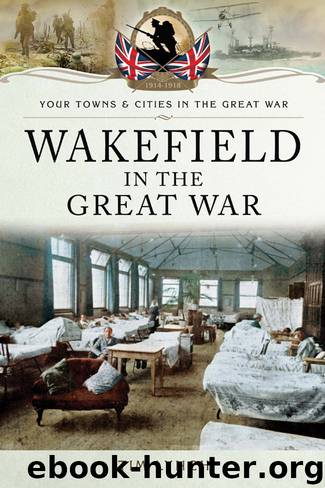Wakefield in the Great War by Tim Lynch

Author:Tim Lynch
Language: eng
Format: epub
Tags: HISTORY / Military / World War I
Publisher: Pen and Sword Military
Published: 2017-07-30T04:00:00+00:00
From Gunner Gravett’s collection of souvenir postcards, an image of his mates in training. (Courtesy of Richard Knowles)
Mates of Gunner Gravett pose for a studio portrait before deployment overseas (Courtesy of Richard Knowles)
Even being wounded was cause for a souvenir picture. (Courtesy of Richard Knowles)
As the first Christmas of the war approached, a great deal of effort was made to ensure that every Wakefield man serving in the forces received a gift of some description. The retreat from Mons had seen hundreds of British soldiers taken prisoner and a Wakefield Prisoner of War Fund was established with its headquarters in the home of Canon Richard Phipps, the Wakefield Diocesan Secretary, and his wife at Manygates House. By October 1915, Mrs Phipps had recruited thirty-three Wakefield women who each maintained contact with one of the men held at Doberitz Camp in Germany. Pupils at Wakefield Girls High School provided parcels for twelve further men and another twelve were catered for directly from the Fund. Most of the men were members of KOYLI, the Duke of Wellington’s Yorkshire Regiment or the Royal Navy. According to the Wakefield Express, Thomas Parkes of the Royal Navy wrote to Mrs Phipps to thank the organisation for gifts of foodstuffs, shirts, scarves and tobacco and Private J. Mason, KOYLI, reported in a letter that he had received three parcels from the Mayoress, Mrs Stonehouse. Working with General Sir A. Wynne, the KOYLI Prisoner of War Secretary, by September 1916 the group was in a position to send each known prisoner from Wakefield a complete set of outer clothing and two sets of under garments. Bread was supplied twice weekly from Switzerland and each man received a weekly food parcel worth 4s. Letters to and from prisoners of war passed through neutral countries and a similar arrangement was in place for the men held in Lofthouse Park.
When the time came for the Wakefield men of the KOYLI to go to France in April 1915, sharing letters home became a way of keeping family, friends and neighbours informed about what was going on and at first it seemed as though they were having fun. Sergeant Herbert Henson was in charge of two machine-guns and in his first letter home he described the scene: ‘They call them trenches but they are more like forts it consists of sandbags making a parapet 6ft high above the level of the ground and behind are the dugouts. The dugouts are like a little colony of huts they consist of earthwork and sandbags about 3ft high with a roof of corrugated iron on top and earth … We had four gun emplacements about 100 yards apart or so covered over from areoplane [sic] observation they were quite alright … We have six men per gun and out of that we had to provide a sentry through the daytime and night time 2 men on duty and 1 sentry. I have had about a couple of hours sleep each night and get the rest
Download
This site does not store any files on its server. We only index and link to content provided by other sites. Please contact the content providers to delete copyright contents if any and email us, we'll remove relevant links or contents immediately.
The Vikings: Conquering England, France, and Ireland by Wernick Robert(79846)
Ali Pasha, Lion of Ioannina by Eugenia Russell & Eugenia Russell(40104)
The Conquerors (The Winning of America Series Book 3) by Eckert Allan W(36960)
The Vikings: Discoverers of a New World by Wernick Robert(36903)
Cecilia; Or, Memoirs of an Heiress — Volume 1 by Fanny Burney(32396)
Cecilia; Or, Memoirs of an Heiress — Volume 3 by Fanny Burney(31778)
Cecilia; Or, Memoirs of an Heiress — Volume 2 by Fanny Burney(31749)
Empire of the Sikhs by Patwant Singh(22925)
The Secret History by Donna Tartt(18788)
Hans Sturm: A Soldier's Odyssey on the Eastern Front by Gordon Williamson(18448)
Cat's cradle by Kurt Vonnegut(15127)
Pimp by Iceberg Slim(14262)
Sapiens: A Brief History of Humankind by Yuval Noah Harari(14185)
Talking to Strangers by Malcolm Gladwell(13158)
Norse Mythology by Gaiman Neil(13156)
Leonardo da Vinci by Walter Isaacson(13128)
4 3 2 1: A Novel by Paul Auster(12245)
Underground: A Human History of the Worlds Beneath Our Feet by Will Hunt(11992)
The Radium Girls by Kate Moore(11886)
